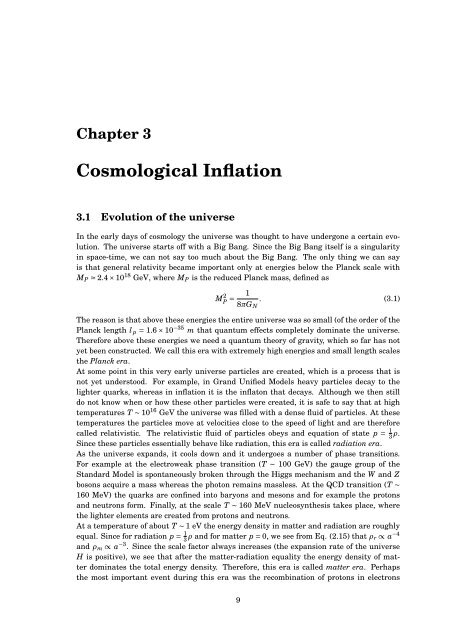Master's Thesis in Theoretical Physics - Universiteit Utrecht
Master's Thesis in Theoretical Physics - Universiteit Utrecht
Master's Thesis in Theoretical Physics - Universiteit Utrecht
Create successful ePaper yourself
Turn your PDF publications into a flip-book with our unique Google optimized e-Paper software.
Chapter 3Cosmological Inflation3.1 Evolution of the universeIn the early days of cosmology the universe was thought to have undergone a certa<strong>in</strong> evolution.The universe starts off with a Big Bang. S<strong>in</strong>ce the Big Bang itself is a s<strong>in</strong>gularity<strong>in</strong> space-time, we can not say too much about the Big Bang. The only th<strong>in</strong>g we can sayis that general relativity became important only at energies below the Planck scale withM P ≃ 2.4 × 10 18 GeV, where M P is the reduced Planck mass, def<strong>in</strong>ed asM 2 P = 18πG N. (3.1)The reason is that above these energies the entire universe was so small (of the order of thePlanck length l p = 1.6 × 10 −35 m that quantum effects completely dom<strong>in</strong>ate the universe.Therefore above these energies we need a quantum theory of gravity, which so far has notyet been constructed. We call this era with extremely high energies and small length scalesthe Planck era.At some po<strong>in</strong>t <strong>in</strong> this very early universe particles are created, which is a process that isnot yet understood. For example, <strong>in</strong> Grand Unified Models heavy particles decay to thelighter quarks, whereas <strong>in</strong> <strong>in</strong>flation it is the <strong>in</strong>flaton that decays. Although we then stilldo not know when or how these other particles were created, it is safe to say that at hightemperatures T ∼ 10 16 GeV the universe was filled with a dense fluid of particles. At thesetemperatures the particles move at velocities close to the speed of light and are thereforecalled relativistic. The relativistic fluid of particles obeys and equation of state p = 1 3 ρ.S<strong>in</strong>ce these particles essentially behave like radiation, this era is called radiation era.As the universe expands, it cools down and it undergoes a number of phase transitions.For example at the electroweak phase transition (T ∼ 100 GeV) the gauge group of theStandard Model is spontaneously broken through the Higgs mechanism and the W and Zbosons acquire a mass whereas the photon rema<strong>in</strong>s massless. At the QCD transition (T ∼160 MeV) the quarks are conf<strong>in</strong>ed <strong>in</strong>to baryons and mesons and for example the protonsand neutrons form. F<strong>in</strong>ally, at the scale T ∼ 160 MeV nucleosynthesis takes place, wherethe lighter elements are created from protons and neutrons.At a temperature of about T ∼ 1 eV the energy density <strong>in</strong> matter and radiation are roughlyequal. S<strong>in</strong>ce for radiation p = 1 3 ρ and for matter p = 0, we see from Eq. (2.15) that ρ r ∝ a −4and ρ m ∝ a −3 . S<strong>in</strong>ce the scale factor always <strong>in</strong>creases (the expansion rate of the universeH is positive), we see that after the matter-radiation equality the energy density of matterdom<strong>in</strong>ates the total energy density. Therefore, this era is called matter era. Perhapsthe most important event dur<strong>in</strong>g this era was the recomb<strong>in</strong>ation of protons <strong>in</strong> electrons9
















